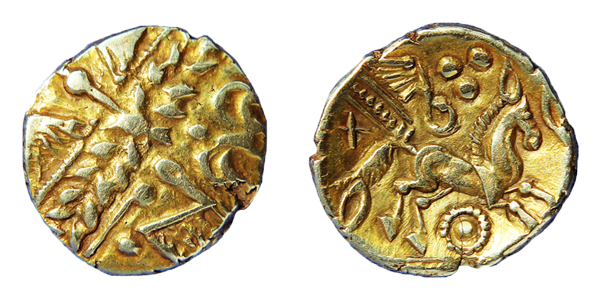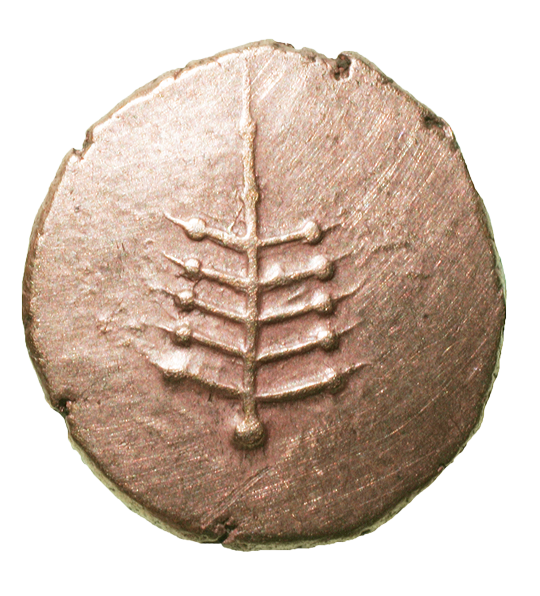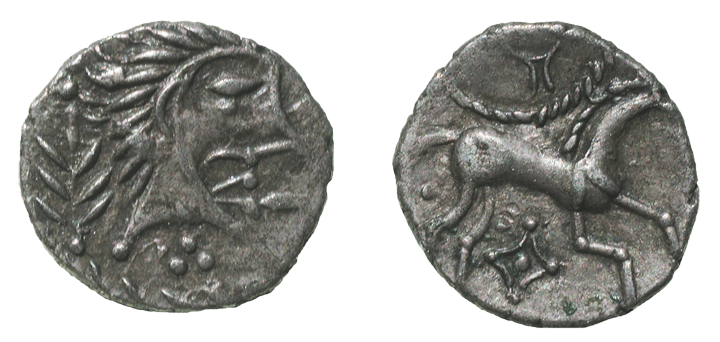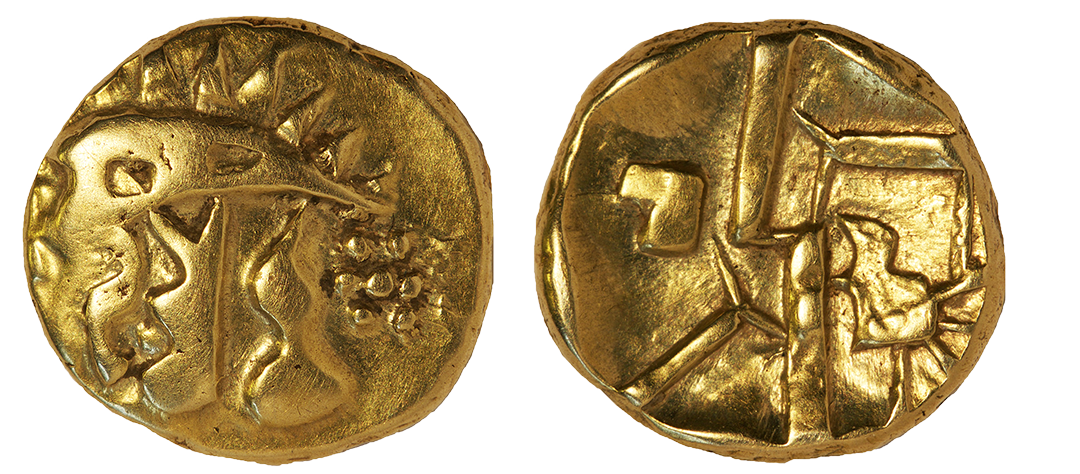
Numismatic Articles
Van Arsdell 2018b (Info)
Semiotics of Celtic Coins XIII – Identifying and Interpreting Inventions
By Robert D. Van Arsdell
Inventions are those wonderful images that entice people to study Celtic coins. The imagery is complex, made with a multitude of abstract elements arranged in a dreamlike scene. One is drawn to the image because it seems to hold some deep and secret meaning.
Yet, nothing of the sort need be the case. Although the semiotic analysis will be complicated, the ultimate meaning may be quite simple. Looking further, the way the images are constructed can give us insight into the problems a Celtic ruler faced. The sophistication of the propaganda unleased on the coins tells a story all its own. Inventions can give us a view into Celtic times and social relations beyond the meanings of the image.
The next few articles will reveal how to spot Inventions (as opposed to Replicas) and how to interpret them. The discussion will turn to the way Inventions are concocted and how they are mapped.
Spotting Inventions
Although Inventions are often complex images, a better way of spotting them is to eliminate the obvious Replicas (emblems) and declare anything else an Invention. That means most Celtic coin images are Inventions, not Replicas. Replicas fall into a category defined by a set of three rules involving time, consistency and place.

The emblem on this Dobunnic gold stater is the best example of a Replica we have. It meets all three criteria to declare it a Replica:
1) It is used on coins for a long period of time.
2) It doesn't change in appearance very much.
3) It is only used on coins from a distinct region.
The rationale is that a national emblem will only be used by a single issuing authority from a given geographic region (a detail). The image must be reproduced over and over in a predictable way to maintain the proprietary nature of the emblem (exceptions).
Occasionally, a Replica may be used for a short time. Personal emblems of individual rulers would would be examples.
Generally however, if an image fails to meet any of the three criteria, it is best declared an Invention.
Some examples of Inventions

The imagery on this Whaddon Chase stater can easily be declared an Invention. Though the Whaddon Chase type is primarily used north of the Thames, it is only for a relatively short period of time. Thus it fails to meet the first criteria.
The complex nature of the image gives us added confidence that it is an Invention.

The imagery on this Icenian silver unit can also be declared an Invention. Though this coin type is used in only one region, this exact image is used for only a short time.
The Head/Horse motif of the Iceni is admittedly used for a long time with virtually no changes. But this specific image is different from the rest. Its appearance is unlike the other coins in the series (and also those coins inscribed ANTED, ECEN, EISV or SAENV). Furthermore it has the added branched object behind the head. We might suspect that the meaning of the head and the branched object combine to produce a new meaning – that an Amalgamation Switch is involved. Any time an Amalgamation Switch is suspected, the Image is best declared an Invention.
Again, the overall image is made up of numerous objects, giving an additional confidence that the image an Invention.

This Geometric Type quarter stater may also be declared an Invention. Though it has images that remain fairly consistent over time, its wide geographic range suggests it's not the work of a single issuing authority. Thus it's best considered an Invention (details).
Interpreting Inventions
The following discussion gives the procedure for analyzing a Celtic coin image. The goal is to write a plausible sememe diagram of the image's meaning.
It's important to note that we have no written account from ancient times about the images on these coins or their meanings. Thus, we can never prove that any of our assigned meanings are what ancient people understood. We are looking for plausibility, not certainty.
It is entirely possible, even expected, that an image can have several meanings. This situation is no different from that which would have been the case in ancient times. The received meaning will often have depended on the ancient viewer's point of view – and that may have been different from the ruler's. Thus, the analysis gives us the opportunity to detect miscommunications from rulers, and cases where rulers show a canny understanding of their subjects.
That this procedure can be written down shows that this technique is not really one of Deconstruction. Deconstruction warns that by reducing the analysis to a procedure or set of rules we run the risk of predetermining the results – that we will merely find what we seek. In the case of Celtic coin imagery, this is a risk worth running. But workers using the procedure must be on guard that they do not use it to prove that which they already "know". One way to minimize the risk is to run the procedure multiple times and come up with multiple meanings. The merits of the competing results can be debated, and more plausible sememe diagrams can be then constructed.
Each step in the procedure has been discussed at length in a previous article. Thus, the goal here is to place the steps in a useful order and guide the reader to the detailed articles about them.
1) Identify the image as an Invention (and not a Replica)
Most images on Celtic coins are Inventions, so it's is easier to identify Replicas and declare anything else an Invention (see the first part of this article for guidance) (see another relevant article).
2) Analyzing the image
The image is dissected and each element interpreted independently. Some elements may be mere decorations, carrying no real meaning, others may be artistic flourishes that may or may not influence the meaning (see relevant article).
3) Create an "Inventory of Objects"
Create a separate list of objects for each side of the coin. This will be used to create a list of Codes for constructing the sememe diagram.
4) Search for Codes
Try to identify each object to the extent possible and assign a suitable Denotation. Then try to assign a Code to each object by adding plausible Connotations to the Denotation (see relevant article).
5) Search for Amalgamation Switches
Search for groups of image elements whose meanings may combine to create a completely new meaning. There may be several of these groups, and the groups may include objects on both sides of the coin (see relevant article).
6) Search for the use of Circumstance Selectors
Identify image elements that might have different Codes, depending on who the viewer might be. For example wealthy farmers might have different interests than the warriors in society – and would interpret an image differently (see relevant article).
7) Search for metaphors
Some image elements may have codes that are hidden because a metaphor is involved. There should be few of these cases, but it is worth the effort to find them (see relevant artcle).
8) Construct Sememe Diagram
Group all the Denotation and Connotation items in a sememe diagram taking into account Circumstance Selectors and Amagamation Switches (see relevant article) (see another relevant article).
9) Search for archaeological or documentary justification
Look for justification in the archaeological record, or the writings of the ancient authors that the Denotations and Connotations assigned to the images are plausible (see relevant article) (see another relevant article) (see another relevant article).
Goal: come up with a sememe diagram that is plausable interpretation of the meaning of the image.
There is much more to discuss regarding sememe diagrams. Mapping will reveal how Inventions are concocted and whether they should be overcoded or undercoded. It will also provide insight into the way rulers may have been influenced in their choice of images.
A discussion of Umberto Eco's idea of "Extensions into the Continuum" will provide insight into the ways rulers may have viewed and exploited coin imagery to influence their subjects. It can also provide analytical techniques that reveal whether the rulers were likely to have succeeded.
END
